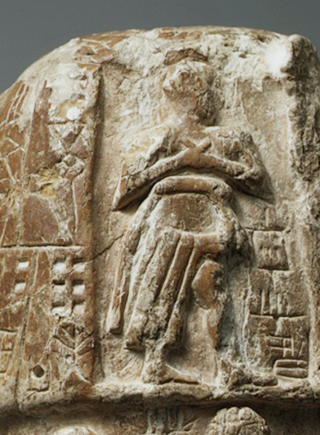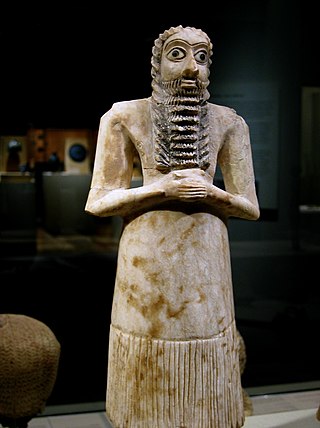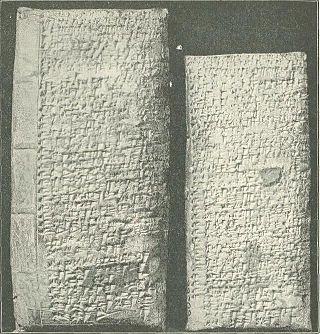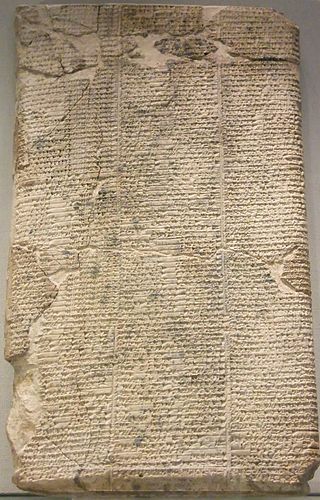(Shulgi D)
| Part of a series on |
| Ancient Mesopotamian religion |
|---|
 |
Self-praise of Shulgi (Shulgi D) is a Sumerian hymn dedicated to the Third Dynasty of Ur ruler Shulgi, written on clay tablets dated to between 2100 and 2000 BC.
| Part of a series on |
| Ancient Mesopotamian religion |
|---|
 |
Self-praise of Shulgi (Shulgi D) is a Sumerian hymn dedicated to the Third Dynasty of Ur ruler Shulgi, written on clay tablets dated to between 2100 and 2000 BC.
The hymn was discovered on the University of Pennsylvania Museum of Archaeology and Anthropology, catalogue of the Babylonian section (CBS), tablet number 11065 from their excavations at the temple library at Nippur. This was translated by George Aaron Barton in 1918 and first published as "Sumerian religious texts" in "Miscellaneous Babylonian Inscriptions", number three, entitled "Hymn to Dungi" (Dungi was later renamed to Shulgi). [1] The tablet is 7 inches (18 cm) by 5.4 inches (14 cm) by 1.6 inches (4.1 cm) at its thickest point. [2] Barton noted that similar hymns were published by Stephen Herbert Langdon and introduced into Sumerian religion at the time of the Third dynasty of Ur onwards. He dates the tablet to the reign of Shulgi, saying "The script of our tablets shows that this copy was made during the time of the First Dynasty of Babylon, but that does not preclude an earlier date for the composition of the original." [2] Further tablets were used by Jacob Klein to expand and translate the myth again in 1981. He used several other tablets from the University Museum in Pennsylvania including CBS 8289. He also included translations from tablets in the Nippur collection of the Museum of the Ancient Orient in Istanbul, catalogue number 4571. He also used tabled 5379 from the Louvre in Paris. [3]
In the story, Shulgi is praised and compared to all manner of animals and wondrous things such as a tree.
"You are as strong as an ildag tree planted by the side of a watercourse. You are a sweet sight, like a fertile mec tree laden with colourful fruit. You are cherished by Ninegala, like a date palm of holy Dilmun. You have a pleasant shade, like a sappy cedar growing amid the cypresses." [4]
His interactions and relationships with a large number of the pantheon of Sumerian gods are described along with victories in foreign lands and description of the royal barge.
"Imbued with terrible splendour on the Exalted River, it was adorned with holy horns, and its golden ram symbol gleamed in the open air. Its bitumen was the ... bitumen of Enki provided generously by the abzu; its cabin was a palace. It was decorated with stars like the sky. Its holy ..." [4]
Samuel Noah Kramer suggests that Shulgi hymns speaking about the achievements of the king focussed on the two areas of social behaviour and religion. He is both shown to be concerned for social justice, law and equity along with being faithful in his priestly rites and interaction with the gods. He notes "uppermost in their minds was the Ekur, the holy temple of Nippur where virtually every king in the hymnal repertoire brought gifts, offerings, and sacrifices to Enlil." [5]

Enlil, later known as Elil, is an ancient Mesopotamian god associated with wind, air, earth, and storms. He is first attested as the chief deity of the Sumerian pantheon, but he was later worshipped by the Akkadians, Babylonians, Assyrians, and Hurrians. Enlil's primary center of worship was the Ekur temple in the city of Nippur, which was believed to have been built by Enlil himself and was regarded as the "mooring-rope" of heaven and earth. He is also sometimes referred to in Sumerian texts as Nunamnir. According to one Sumerian hymn, Enlil himself was so holy that not even the other gods could look upon him. Enlil rose to prominence during the twenty-fourth century BC with the rise of Nippur. His cult fell into decline after Nippur was sacked by the Elamites in 1230 BC and he was eventually supplanted as the chief god of the Mesopotamian pantheon by the Babylonian national god Marduk.

Nippur was an ancient Sumerian city. It was the special seat of the worship of the Sumerian god Enlil, the "Lord Wind", ruler of the cosmos, subject to An alone. Nippur was located in modern Nuffar in Afak, Al-Qādisiyyah Governorate, Iraq. It is roughly 200 kilometers south of modern Baghdad and about 60 miles southeast of the ancient city of Babylon. Occupation at the site extended back to the Ubaid period, the Uruk period, and the Jemdet Nasr period. The origin of the ancient name is unknown but different proposals have been made.

Lugalbanda was a deified Sumerian king of Uruk who, according to various sources of Mesopotamian literature, was the father of Gilgamesh. Early sources mention his consort Ninsun and his heroic deeds in an expedition to Aratta by King Enmerkar.

The Lament for Ur, or Lamentation over the city of Ur is a Sumerian lament composed around the time of the fall of Ur to the Elamites and the end of the city's third dynasty.
The Dynasty of Isin refers to the final ruling dynasty listed on the Sumerian King List (SKL). The list of the Kings Isin with the length of their reigns, also appears on a cuneiform document listing the kings of Ur and Isin, the List of Reigns of Kings of Ur and Isin.

Aga commonly known as Aga of Kish, was the twenty-third and last king in the first dynasty of Kish during the Early Dynastic I period. He is listed in the Sumerian King List and many sources as the son of Enmebaragesi. The Kishite king ruled the city at its peak, probably reaching beyond the territory of Kish, including Umma and Zabala.

George Aaron Barton was a Canadian author, Episcopal clergyman, and professor of Semitic languages and the history of religion.

The Barton Cylinder, also known as CBS 8383, is a Sumerian creation myth, written on a clay cylinder in the mid to late 3rd millennium BCE, which is now in the University of Pennsylvania Museum of Archaeology and Anthropology. Joan Goodnick Westenholz suggests it dates to around 2400 BC.

The "Debate between sheep and grain" or "Myth of cattle and grain" is a Sumerian creation myth, written on clay tablets in the mid to late 3rd millennium BC.

The Debate between Winter and Summer or Myth of Emesh and Enten is a Sumerian creation myth, written on clay tablets in the mid to late 3rd millennium BC.

Enlil and Ninlil or the Myth of Enlil and Ninlil or Enlil and Ninlil: The begetting of Nanna is a Sumerian creation myth, written on clay tablets in the mid to late 3rd millennium BC.

The Old Babylonian oracle is a Sumerian myth, written on clay tablets dated to between 2340 and 2200 BC.

The Kesh temple hymn, Liturgy to Nintud, or Liturgy to Nintud on the creation of man and woman, is a Sumerian tablet, written on clay tablets as early as 2600 BCE. Along with the Instructions of Shuruppak, it is the oldest surviving literature in the world.

The Hymn to Enlil, Enlil and the Ekur (Enlil A), Hymn to the Ekur, Hymn and incantation to Enlil, Hymn to Enlil the all beneficent or Excerpt from an exorcism is a Sumerian myth, written on clay tablets in the late third millennium BC.

Miscellaneous Babylonian Inscriptions is a 1918, Sumerian linguistics and mythology book written by George Aaron Barton.

The Song of the hoe or the Creation of the pickax is a Sumerian creation myth, written on clay tablets from the last century of the 3rd millennium BCE.
Shu-Ilishu was the 2nd ruler of the dynasty of Isin. He reigned for 10 years Shu-Ilishu was preceded by Išbi-erra. Iddin-Dagān then succeeded Shu-Ilishu. Shu-Ilishu is best known for his retrieval of the cultic idol of Nanna from the Elamites and its return to Ur.
Iddin-Dagan, fl.c. 1910 BC — c. 1890 BC by the short chronology or c. 1975 BC — c. 1954 BC by the middle chronology) was the 3rd king of the dynasty of Isin. Iddin-Dagan was preceded by his father Shu-Ilishu. Išme-Dagān then succeeded Iddin-Dagan. Iddin-Dagan reigned for 21 years He is best known for his participation in the sacred marriage rite and the sexually-explicit hymn that described it.

Būr-Sîn, c. 1831 – 1811 BC or c. 1895 – 1874 BC was the 7th king of the 1st Dynasty of Isin and ruled for 21 years according to the Sumerian King List, 22 years according to the Ur-Isin king list. His reign was characterized by an ebb and flow in hegemony over the religious centers of Nippur and Ur.

Kindattu was the 6th king of the Shimashki Dynasty, in Elam, at the time of the third dynasty of Ur in ancient Lower Mesopotamia.